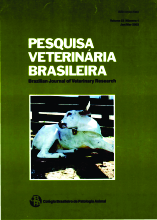 |
|
|
|
Year 2003 - Volume 23, Number 1
|

|
Sudden deaths in cattle associated with copper deficiency, 23(1):21-32
|
ABSTRACT.- Marques A.P., Riet-Correa F., Soares M.P., Ortolani E.L. & Giuliodori M.J. 2003. (Sudden deaths in cattle associated with copper deficiency.] Mortes súbitas em bovinos associadas à carência de cobre. Pesquisa Veterinária Brasileira 23(1):21-32. Laboratório Regional de Diagnóstico, Faculdade de Veterinária, Universidade Federal de Pelotas, 96010-900, Pelotas, RS, Brazil.
An outbreak of sudden death was observed in cattle in southern Brazil. No significant gross or microscopic lesions were found in 1 O cattle at post-mortem examination. To test if the sudden deaths were caused by a toxic plant, 13 weeds were collected and given to rabbits at a total of 440 to 600 g per kg body weight within 7 days. Results were negative. Mean copper levels of the tiver in 10 cattle were very low (3.6± 1.6 ppm-dry matter) suggesting Cu deficiency as the cause of the disease. Five samples of pasture collected during the outbreak had normal levels of Cu (8.4±0.8 ppm-d.m.) and S (0.2%±0.03-d.m.), but high levels of Fe (522± 122 ppm-d.m.). One group of 10 heifers was supplemented with Cu subcutaneously. This group and a similar control group were maintained in the sarne area where the outbreak occurred. Serum levels of Cu, S, Fe, Mo and ceruloplasmin were determined bimonthly in both groups during one year. Mean serum levels of Cu (1.76± 1.06 to 10.34±3.1 μmol/1 for the control group and 3.86± 1.53 to 10.61 ± 1.34 μmol/1 for the treated group) and ceruloplasmin (6.59±3.93 to 18.61±4.14 mg/1 for the control group and 10.31±5.48 to 32.49±6.05 mg/1 for the treated group) were significantly higher in the supplemented group (P=0.0046 for Cu and P=0.0001 for ceruloplasmin), but they were below normal levels in most samples of both groups. Serum levels of Cu and ceruloplasmin were correlated (r=0.67; P=00.5). ln both groups serum levels of Fe (40.09±5.25 to 78.48±28.23 μmol/1) were higher than normal levels. Samples of forage were collected bimonthly for determination of Cu, Mo, S, Fe and protein in 7 points of the paddock where the outbreak occurred. Levels of Cu (1.36±0.56 to 4.76±1.15 ppm-d.m.) were below the normal ranges. The concentration of Mo (0.17±0.06 to 0.96±0.47 ppm-d.m.) was within normal ranges. Levels of S (0.21 ±0.04% to 0.5±0.17%) and Fe (172.92±62.64 to 437.24±205.44 ppm-d.m.) were occasionally within toxic level. Levels of protein varied from 7.77±2.6% to 13.16±3.02%. Six samples of water and six of submersed pastures were collected at the end of the experiment when the paddock was flooded. High levels of iron (169.23±83.49 ppm-d.m.) and S (0.06±0.03%) were found in the water. Levels of Fe and S in the submerse pasture were of 469.3±218.28 ppm and 0.19 ±0.05%, respectively. The results obtained suggest that the sudden deaths are due to Cu deficiency. Three factors seem to be responsible for the Cu deficiency: 1) high levels of iron in pastures and water; 2) occasionally low levels of copper in the pastures; and 3) the ingestion of S above the requirements due to the levels occasionally high in pastures and high in water. The outbreak reported is similar to other outbreaks of sudden deaths associated with low liver copper previously reported during winter in the sarne region of southern Brazil. This area is characterized by acid sandy soils with frequent flooding during this season. ln periodically flooded acid soils iron is solubilized and absorbed by the plants, decreasing the Cu content and increasing the Fe content of forage. This seems to be the main reason for Cu deficiency in the region. |
| |
|
|
| |
|
 |